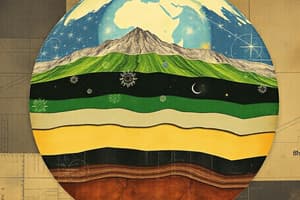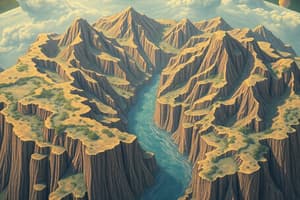Podcast
Questions and Answers
Which layer of the Earth is primarily composed of liquid iron and nickel?
Which layer of the Earth is primarily composed of liquid iron and nickel?
- Upper mantle
- Inner core
- Outer core (correct)
- Oceanic crust
What percentage of the Earth's surface is made up of continental crust?
What percentage of the Earth's surface is made up of continental crust?
- 100%
- 40% (correct)
- 71%
- 50%
Which layer is characterized by a thick composition mainly of silicon, oxygen, iron, and magnesium?
Which layer is characterized by a thick composition mainly of silicon, oxygen, iron, and magnesium?
- Crust
- Lithosphere
- Core
- Mantle (correct)
What is the primary characteristic of the troposphere?
What is the primary characteristic of the troposphere?
Which of the following is NOT one of the Earth’s subsystems?
Which of the following is NOT one of the Earth’s subsystems?
What is the main purpose of the greenhouse gases in the atmosphere?
What is the main purpose of the greenhouse gases in the atmosphere?
What is the term used for the frozen part of Earth's hydrosphere?
What is the term used for the frozen part of Earth's hydrosphere?
Which layer of the atmosphere is described as the 'weather zone'?
Which layer of the atmosphere is described as the 'weather zone'?
Which layer of the Earth does not have a solid structure?
Which layer of the Earth does not have a solid structure?
What is the main feature of the asthenosphere?
What is the main feature of the asthenosphere?
Which layer of the atmosphere contains the ozone layer?
Which layer of the atmosphere contains the ozone layer?
How is the Earth characterized in terms of life?
How is the Earth characterized in terms of life?
Which of the following layers is the first layer adjacent to space?
Which of the following layers is the first layer adjacent to space?
What is the primary composition of the inner core?
What is the primary composition of the inner core?
Which subsystem of the Earth is primarily associated with water?
Which subsystem of the Earth is primarily associated with water?
What percentage of the Earth’s surface is covered by water in the hydrosphere?
What percentage of the Earth’s surface is covered by water in the hydrosphere?
Flashcards are hidden until you start studying
Study Notes
Geosphere Composition
- Composed of the crust, mantle, outer core, and inner core.
- Crust serves as Earth's solid exterior and is the thinnest layer.
- Two types of crust:
- Continental Crust: Accounts for 40% of Earth's surface, forms continents.
- Oceanic Crust: Makes up ocean basins.
- Plate tectonics theory explains crust's structure as several large, rigid plates.
- Plate boundaries include divergent, convergent, and transform zones.
Mantle
- Thicker layer compared to crust, composed mainly of silicon, oxygen, iron, and magnesium.
- Constitutes 83% of Earth’s interior, divided into upper and lower mantle.
- Lithosphere includes the uppermost mantle and crust, characterized by hard, strong rocks.
- Asthenosphere is a weaker, ductile layer of molten-like material within the mantle.
Core
- Innermost section with a radius of 3,360 km, larger than the planet Mars.
- Composed of iron and nickel; divided into:
- Outer Core: Liquid state, primarily iron and nickel.
- Inner Core: Solid, very dense ball of iron, extremely hot.
Earth
- The only known planet to host life, recognized for its blue water and land masses.
- Characterized by dynamic systems, including lithosphere, hydrosphere, atmosphere, and biosphere.
Atmosphere
- Thin layer of gases surrounding Earth; consists of:
- 78% Nitrogen, 21% Oxygen, 0.9% Argon.
- Greenhouse gases maintain temperatures favorable for life.
- Provides protection from high-energy radiation.
- Composed of several layers:
- Troposphere: Closest layer (8-16 km), where weather occurs.
- Stratosphere: Contains the ozone layer, which absorbs UV radiation.
- Mesosphere: Temperature decreases; where meteors burn.
- Thermosphere: Temperature exceeds 1100°C; air is extremely thin.
- Exosphere: Outermost layer where atoms escape into space.
Hydrosphere
- Represents all water on Earth, which exists as liquid, vapor, and ice.
- Covers 71% of Earth's surface, predominantly in oceans.
- Only 3% of Earth’s water is fresh.
- The cryosphere refers to frozen water.
- The hydrologic cycle includes processes such as condensation, precipitation, evaporation, transpiration, infiltration, and surface runoff.
Geosphere
- Solid Earth extending from the surface to the core, referred to as "Geo" meaning ground.
- Incorporates the crust and upper mantle.
- Alfred Wegener proposed the concept of Pangaea, suggesting continents were once joined.
Biosphere
- "Bio" means life; it encompasses all living organisms.
- Interaction among land, water, and air supports life.
- Term coined by geologist Edward Suess in 1875, encompasses all ecosystems.
Geosphere Composition
- Earth consists of several layers: Crust, Mantle, Outer Core, and Inner Core, each with distinct properties.
- The Crust is the solid exterior, thin compared to other layers, comprising Continental and Oceanic Crust.
- Oceanic Crust makes up ocean basins, while Continental Crust accounts for 40% of Earth's surface.
- Plate Tectonics theory suggests Earth's crust and upper mantle comprise large, rigid plates that interact at boundaries (Divergent, Convergent, Transform).
Mantle
- Thicker than the crust, composed primarily of Silicon, Oxygen, Iron, and Magnesium.
- Largest interior zone, making up 83% of Earth's volume, divided into Upper Mantle and Lower Mantle.
- The Lithosphere includes the uppermost mantle and overlying crust, consisting of hard rocks.
- The Asthenosphere is a region of molten, plastic-like material, characterized by weak, ductile rock.
Core
- The innermost section with a radius of 3,360 km, larger than Mars.
- Outer Core is liquid, composed of Iron and Nickel; Inner Core is solid and extremely hot.
Earth Overview
- Earth is the only known planet to host life, characterized by blue oceans, rocky landmasses, and diverse ecosystems.
- Comprised of interactive systems, creates a dynamic, constantly changing planet.
Subsystems
- The geosphere includes several subsystems: Lithosphere, Hydrosphere, Atmosphere, Biosphere.
- These systems interact continuously, exemplified by the Water Cycle.
Atmosphere
- A thin layer of gases around Earth, mostly 78% Nitrogen, 21% Oxygen, and 0.9% Argon.
- Greenhouse gases help maintain the planet's temperature conducive to life and protect against high-energy radiation.
- Layers of the atmosphere include Troposphere, Stratosphere, Mesosphere, Thermosphere, and Exosphere.
Troposphere
- Closest layer to the Earth's surface (8-16 km), known as the "weather zone."
Stratosphere
- Located above the troposphere, reaching 50 km high; contains the Ozone Layer that absorbs UV radiation.
Mesosphere
- Temperature decreases with altitude; where meteors burn upon entry.
Thermosphere
- Temperature climbs sharply, reaching about 1100°C; air is very thin at this layer.
Exosphere
- Outermost layer; atoms and molecules can escape into space.
Hydrosphere
- Comprises all water on Earth in liquid, vapor, or ice forms; covers 71% of the Earth's surface, primarily as ocean water.
- Only 3% of Earth's water is fresh water.
- The Hydrologic Cycle includes processes like Condensation, Precipitation, Evaporation, Transpiration, Infiltration, and Surface Runoff.
Geosphere
- Extends from Earth's surface to its center; encompasses continents and the upper part of the mantle.
- The theory of Pangaea, proposed by Alfred Wegener, explains the historical movement of continents.
Biosphere
- The zone where all living organisms exist, interacting with land, water, and air to support life.
- The term was coined by geologist Edward Suess in 1875, encompassing all ecosystems.
Studying That Suits You
Use AI to generate personalized quizzes and flashcards to suit your learning preferences.




